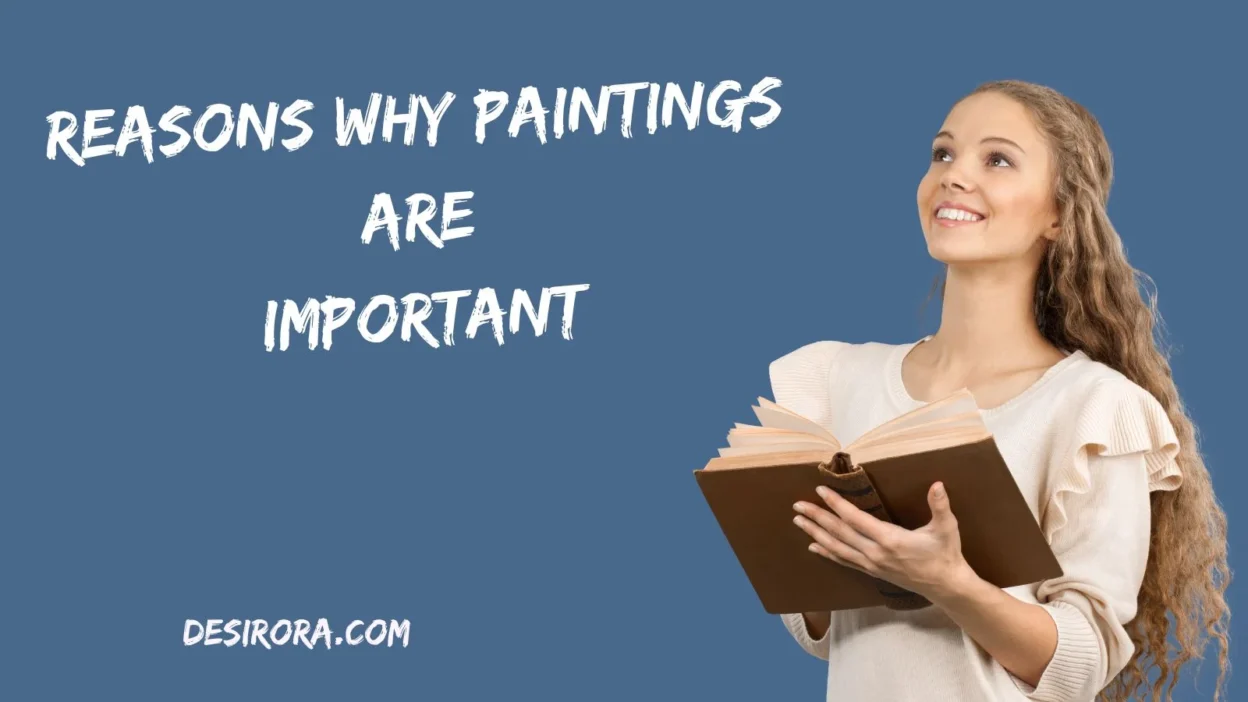Art—especially paintings—holds a special place in human experience. Whether you’re gazing at a canvas in a museum, watching colors swirl under your own brush, or passing a mural on a street, paintings are more than decoration. They’re messages, mirrors, bridges, and even medicine for the soul.
Below, we explore why paintings are important from many angles, with examples, lists, tables, and insights you can apply in everyday life.
Paintings as Emotional Expression and Storytelling
One of the most powerful reasons paintings matter is their ability to express what words often cannot.
- A single brushstroke can carry tension, joy, grief, or longing.
- Abstract works may not depict recognizable figures, yet they resonate emotionally.
- Portraits capture both physical likeness and inner character.
“I found I could say things with color and shapes that I couldn’t say any other way — things I had no words for.” — Georgia O’Keeffe
In many cultures, paintings are narratives: religious scenes, mythological episodes, or social commentaries. For example, murals depicting peace, struggle, or triumph visually narrate human emotions and historical events.
Real-life usage: you might hang a painting at home that calms you when you’re anxious or gives you energy in your workspace. That’s emotional communication through color, line, and form.
Paintings tell stories across time — they freeze a moment, preserve a dream, capture a worldview.
Cultural Legacy and Historical Record
Paintings also act as cultural time capsules. They allow us to travel into the mindset, aesthetics, and values of past ages.
- Renaissance paintings teach us about religious devotion, scientific curiosity, and social hierarchies.
- Indigenous paintings portray traditions, stories, and cosmologies.
- Street art and murals today document social movements, identity struggles, and evolving urban life.
By studying art history, we uncover the values and beliefs of civilizations that preceded us. Paintings become visual archives of human culture.
Consider ancient cave paintings—they reveal how our ancestors viewed hunting, rituals, and survival. Medieval frescoes or modern digital canvases alike reflect their times.
In short: paintings help us remember who we were—and sometimes guide us to who we might become.
Paintings as a Means of Mental Well-Being
Art therapy is a real, evidence-based practice, and painting plays a central role in it.
Why painting helps mental health:
- It functions like mindfulness: you focus on strokes, color, texture, and time slows down.
- It helps release emotions: anger, sadness, and anxiety find an outlet on canvas.
- It reduces stress: engaging in a creative flow state lets the mind relax.
- It can aid healing: people recovering from trauma often use painting to restore calm and rebuild confidence.
A personal example: imagine coming home after a long, draining day. You sit with brushes and pigments for half an hour—not to create a masterpiece, but just to move color around. You find yourself calmer, more centered.
In short: painting can be medicine without a prescription.
Cognitive Growth, Creativity & Problem Solving
Painting is as much about thinking as it is about feeling. It helps sharpen the mind in several ways:
- Neural exercise: planning composition, choosing palettes, and balancing light and shadow stimulate both hemispheres of the brain.
- Memory & concentration: working through details, remembering techniques, and recalling reference images strengthen cognitive skills.
- Problem-solving skills: when a portion of the painting “goes wrong,” artists adapt. Over time, this trains flexible thinking and resilience.
- Fine motor skills: handling brushes and controlling lines enhance coordination and precision.
Essentially, painting teaches you to see problems, explore options, and refine your solutions—skills valuable in any domain.
Social Connection, Dialogue & Change
Paintings aren’t just private experiences—they invite public conversation.
- Galleries, murals, and exhibitions encourage dialogue.
- Artists often use painting to raise awareness of social or environmental issues.
- Shared exhibitions and community art projects build unity and shared identity.
From protest art to memorial murals, paintings have served as rallying cries for justice and compassion. They speak a universal visual language that transcends barriers.
In sum: paintings are bridges—across people, ideologies, and time.
Aesthetic Enrichment and Environmental Impact
Let’s not forget: paintings make life more beautiful. Environments without art often feel stark. With art:
- Rooms feel warm, alive, meaningful.
- Public spaces gain identity—murals can transform a neighborhood.
- Art influences architecture, interior design, and even fashion.
A reproduced poster can’t compete with the presence of an original painting. Real paintings stimulate the senses, invoke emotions, and create a sense of belonging.
The aesthetic value of painting isn’t luxury—it’s nourishment for the human spirit.
Economic Value, Art Markets & Careers
Beyond emotional and cultural worth, paintings also have monetary significance:
- They are assets and investment vehicles.
- Many artists make livelihoods through painting—through commissions, sales, or teaching.
- Museums, galleries, art fairs, and auctions all rely on the painting economy.
- Local economies benefit when art drives tourism or community branding.
Thus, paintings contribute to jobs, industries, and creative economies while keeping human creativity alive and profitable.
Types of Paintings and Their Unique Importance
Different styles and types of painting carry distinct value. Below is a table that highlights their diversity and significance:
| Type of Painting | Key Characteristics | Why It Matters |
| Portrait / Figurative | Human subjects, expression, likeness | Captures identities, emotions, and personal stories |
| Landscape / Nature | Scenes of nature, environment | Preserves beauty, promotes environmental appreciation |
| Abstract / Non-representational | Shapes, colors, textures without obvious subjects | Evokes emotion, invites free interpretation |
| Still Life | Objects, composition, everyday items | Elevates the mundane, tests balance and detail |
| Mural / Street Painting | Large scale, public, site-specific | Democratizes art, engages communities |
| Mixed Media / Experimental | Combines paint with other materials | Encourages innovation, expands boundaries |
| Intuitive / Process Painting | Spontaneous, unplanned, emotionally driven | Heals, explores the subconscious self |
Each type brings something unique: while portraits personalize, abstract painting challenges us to feel rather than “see.” Murals reclaim public spaces. Intuitive painting acts as emotional exploration.
Synonym Table & Grammar Note
Synonyms / related words you might encounter when reading about painting:
| Word | Synonym / Related Term |
| Painting | Artwork, canvas, composition |
| Brushwork | Stroke, mark-making |
| Palette | Color scheme, chromatic set |
| Gallery | Exhibition space, art hall |
| Mural | Fresco, wall painting |
| Medium | Material, technique (oil, acrylic, watercolor) |
Grammar note (active voice vs passive):
- Active: “The artist applied color boldly.”
- Passive: “Color was applied boldly by the artist.”
Active voice is direct, engaging, and better for storytelling or description.
FAQs About Why Paintings Are Important
Q: Can anyone benefit from painting, even non-artists?
A: Absolutely! You don’t need professional skill to enjoy emotional, mental, or creative benefits. Even simple doodles can help you unwind and express yourself.
Q: How do paintings influence culture and identity?
A: Paintings reflect societal values, beliefs, and struggles. They help shape cultural identity and preserve collective memory.
Q: Is digital art less important than traditional painting?
A: Not at all. Digital art continues the legacy of creative expression. However, traditional paintings carry tactile depth and historical continuity that digital formats can’t fully replicate.
Q: What if I don’t “like” art—why should I care?
A: Art surrounds you daily—in design, media, and space. Appreciating painting helps you better understand creativity, communication, and even your emotions.
Q: How can I start painting to experience these benefits?
A: Start small. Pick a canvas or notebook, grab basic colors, and paint without pressure. Enjoy the process more than the result.
Conclusion
Paintings matter deeply for many reasons: they express inner life, preserve our cultural memory, support mental well-being, sharpen the mind, foster social change, enrich our surroundings, and sustain economies. From portraits to abstracts, murals to experimental works, every style adds something vital to the human story.
When you stand before a painting—whether your own or another’s—remember: it’s more than pigment on a surface. It’s emotion made visible, a conversation across time, a tool for healing, and a spark for thought.
In a world filled with fleeting digital images, paintings remind us of texture, patience, and the beauty of the human touch.

Aldous Huxley was a visionary writer and philosopher whose works explored human nature, consciousness, and the future of society. His ideas continue to challenge minds and inspire generations.



